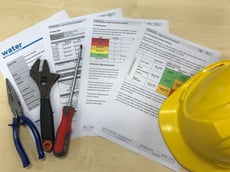A Water Safety Plan (WSP) is defined in BS8680 – 2020 Water Quality. Water Safety Plans. Code of Practice as a proactive and strategic plan which gives clear direction for a business or organisation, whether large or small, to manage the risks identified on-site to prevent harm arising from any form of exposure to water.
It defines and documents the processes and arrangements recommended for the safe use and management of all water systems within each building or estate together with any associated systems and equipment.
Background to a Water Safety Plan
The size and type of water systems can vary enormously depending on the building type and business structure. Developing a robust Water Safety Plan ensures that any potential Legionella risk, and other opportunistic pathogens, identified can be managed safely so that they do not pose a risk to occupiers, the public, or anyone else using or operating these systems. It would also include chemical, physical, and radiological hazards as appropriate.
Where there are several duty holders, e.g. acting as tenants of the landlord, facilities management companies, or PFIs, responsibilities for safe water management should be defined by a contract or tenancy agreement. Landlords or tenants of individual commercial units should also ensure that risks from water are managed effectively, and they might be required to perform certain tasks in respect of this. These arrangements should be covered in the contract, or tenancy agreement, and set out clearly in the Water Safety Plan.
Discussion.
Those responsible for water safety within an organisation or business should implement and develop a documented Water Safety Plan. To develop an effective Water Safety Plan, all potential hazards must be considered, and the potential associated risks assessed.
A thorough gap analysis should be carried out to ensure processes and policies are present, including;
- An organisational structure, policies, and supporting document procedures;
- The process of appointing Water Safety Group members (this includes subcontractors), and up-to-date Terms of Reference for the group.
- Asset management procedures and safe management thereof;
 The management and review of Legionella risk assessments, the quality of water required for each purpose of intended use, particular vulnerabilities, and risks to susceptible people;
The management and review of Legionella risk assessments, the quality of water required for each purpose of intended use, particular vulnerabilities, and risks to susceptible people;
Legionella Risk Assessments and My Water Safety Plan>- A process for appropriate maintenance of assets, including new builds and refurbishment projects;
- A process to verify that ongoing control measures are effective;
- An effective support program for Legionella training and competency checks by way of audits;
- A satisfactory supporting document regime;
- An emergency response protocol to address adverse events,
- Lines of communication and a process to ensure that third parties are not exposed to risks that trained operatives are protected from i.e., aerosol drift.
- Regular reviews of the WSP – It is a live document.
Other considerations.
In a healthcare environment, the likelihood exists that some of the population would be more vulnerable to scalding (physical) hazards and more susceptible to infection, so these areas must be given careful consideration.
Other specialist uses of water should be identified and assessed, such as paint spray booths, quench tanks, water used for commercial purposes, e.g. spray irrigation, water features, recreational uses (including water fountains, aquatic play areas, whirlpool baths, hot tubs), and water used for diagnosis and treatment of patients, e.g. washer-disinfectors, bedpan washers, and sensory tubes.
Conclusion.
A robust Water Safety Plan will ensure that inherent risks associated with water systems are managed effectively and safely and in line with current guidance and legislation.
Having these measures in place and reviewing them regularly protects you, your business or organisation, your staff, and the public.
Further reading> Developing a plan for controlling Legionnaires' Disease
Feel free to reach out if you have any questions about this blog or if you would like to consult with one of our experts for further advice on water hygiene.
Editor’s Note: The information provided in this blog is correct at the date of original publication – February 2022 (Updated March 2024).
© Water Hygiene Centre 2024









